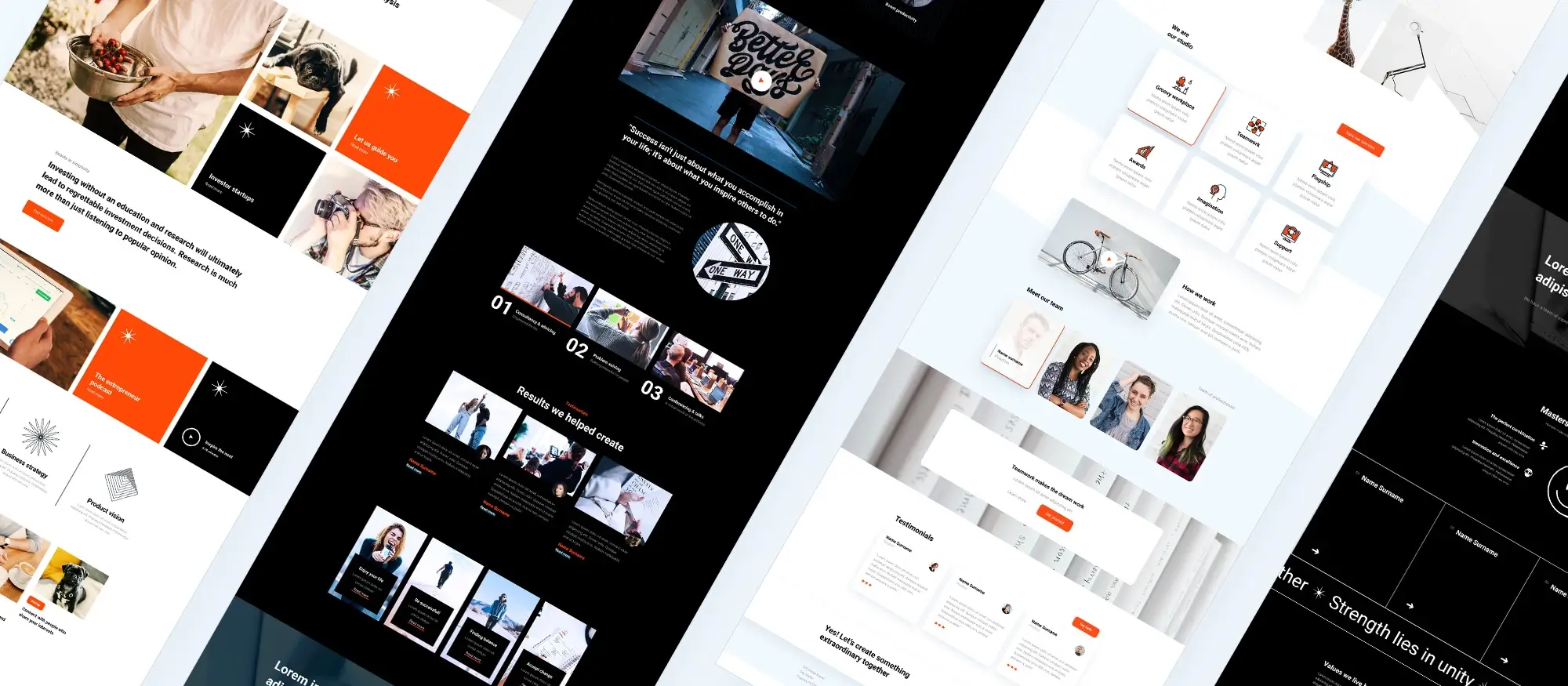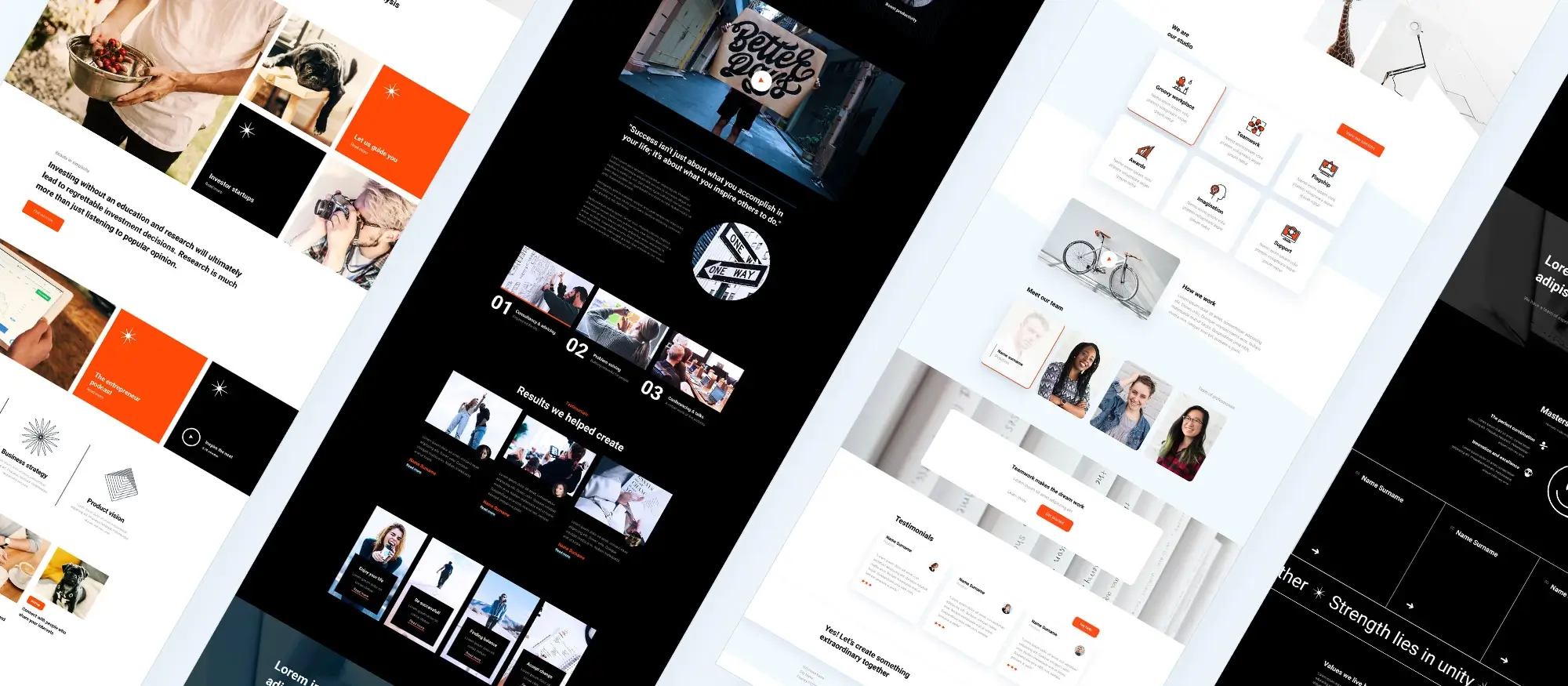8 simple steps to improving WordPress UX design
Try MaxiBlocks for free with 500+ library assets including basic templates. No account required. Free WordPress page builder, theme and updates included.

Updated 15th May 2025
Improve the user experience on your WordPress site
Creating a positive experience for your visitors makes your website more effective. When people can easily find what they need and your site feels smooth and fast, they’re more likely to stay, explore and take action. A good user experience also builds trust and encourages return visits. For WordPress users, getting this right starts with simple design choices and smart plugin use.
Keep your site clear and focused
Your website should immediately communicate its purpose. Whether it’s selling a service, sharing information or building a community, avoid clutter and distractions. A clean layout and a focused message help users understand what they can do on your site.
Make navigation intuitive
A clear navigation menu is one of the most important parts of a good WordPress experience. Choose a few essential links such as your homepage, about page and key services. A menu with fewer than seven items is easier to scan and less overwhelming. Group related content in dropdowns only if it makes the structure clearer. Keep link labels short and descriptive.
Streamline your sidebar
If your theme includes a sidebar, use it wisely. Avoid crowding it with too many widgets or ads. Focus on useful tools such as a search bar, newsletter signup or a list of your most popular content. This helps visitors stay on your site longer by directing them to relevant content without distractions.
Use white space to your advantage
White space helps guide attention and makes content more readable. Instead of cramming everything close together, give your design room to breathe. This makes headlines stand out and improves how visitors understand your layout. Use space around calls to action to make them more visible and inviting.
Speed matters for user experience
Site speed has a direct impact on how people interact with your site. A slow page can cause visitors to leave before they even read your content. Optimise images, use a caching plugin and limit the number of scripts that run in the background. Google PageSpeed Insights is a good tool to check how fast your pages load and what you can improve.

Improve your WordPress site for a better user experience
Build confidence with clear calls to action
Encourage users to take the next step with clear and purposeful language. A well-written call to action helps guide visitors towards a goal, whether that is booking an appointment, reading more, or signing up for updates. Use strong verbs and keep the design simple but noticeable. Test different styles and placements to see what works best. With MaxiBlocks, you can use built-in button blocks with clear contrast settings, hover states, and smooth alignment on all screen sizes. These visual tools make it easy to create call to action areas that users will notice and use.
Make content easy to share on social media
People are more likely to share your posts when the option is obvious and easy. Social sharing buttons should sit in places that feel natural, such as below a blog post or beside product details. Use plugins like ShareThis or AddToAny for integration, or add native buttons with MaxiBlocks so that your design remains clean and unified. This helps more users discover your work and gives your visitors more ways to interact with your content. Social sharing improves reach and builds awareness with very little effort once it is set up correctly.
Focus on a faster and more inclusive experience
A website that is quick to load and works well on any device gives users a better overall experience. Resize images before uploading and consider converting them to WebP to save space. Use a caching plugin to help your pages load faster and test site speed using Google PageSpeed Insights. MaxiBlocks supports modern image formats and includes responsive layout controls so every block looks sharp on desktop and mobile. Combine this with clear menus, well-written headings, and mobile-ready designs to reduce confusion and improve engagement.
Understand what works and keep improving
You cannot fix what you do not measure. Add Google Analytics and other tools to find out where users spend time and where they drop off. Use this information to improve your site layout, content and navigation. Ask for feedback when possible and update your site based on what your audience finds helpful. With MaxiBlocks, you can easily change layouts and blocks without rebuilding your site from scratch. This gives you the freedom to keep testing and refining until you get it right. Making changes based on real user behaviour creates a better website for your audience and better results for your business.
Subscribe to our newsletter
Understanding and improving user experience on your WordPress site
What does improving user experience mean?
Improving user experience is about making your website easier and more enjoyable to use. Start by thinking about what your visitors want and how they interact with your site. Carry out usability testing to uncover points of friction. Review how users move through your pages and simplify wherever you can. Keep navigation clear, reduce loading times, and make sure every part of your site works well on mobile devices. Good visuals, legible fonts, and regularly refreshed content all contribute to a smoother, more satisfying experience. Use tools like MaxiBlocks to help create fast-loading layouts with responsive design and built-in best practices for structure and clarity.
What is UX design in WordPress?
UX design in WordPress refers to the practice of creating a website that looks good and is easy to use. It includes everything from how the menus are laid out to how fast pages load and how the design adapts on smaller screens. Choosing the right theme is a big part of UX design. MaxiBlocks Go, for example, is a lightweight, mobile-ready WordPress theme that works perfectly with the MaxiBlocks plugin. Together, they offer ready-to-use components and patterns that help you build a consistent and user-focused site. Good UX design helps visitors complete tasks easily, encourages them to stay longer, and makes your site feel trustworthy and professional.
What is user experience optimisation?
User experience optimisation means improving different parts of your website to make the overall experience better. This includes making sure the layout is easy to follow, ensuring pages load quickly, and using colours, typography, and spacing that improve readability. Content should be grouped in a way that matches how users think and browse. Optimisation is an ongoing process that involves testing, learning, and refining. With MaxiBlocks, it becomes much easier to test layouts and adjust them quickly. By improving user experience, you reduce bounce rates, increase conversions, and create a website that keeps people coming back.

Simple ways to optimise user experience in WordPress
A practical example of improving UX in WordPress
Improving user experience in WordPress does not have to be complex. For example, you could choose a lightweight and responsive theme such as Astra or GeneratePress. Pair this with a performance plugin like WP Super Cache or LiteSpeed Cache to boost site speed. For interaction, a user-friendly plugin like WPForms can make contact forms easier to use. The key is to test regularly on different devices and browsers and make adjustments based on user behaviour and feedback. If you are building from scratch, using a solution like MaxiBlocks gives you a head start with fast-loading templates, pre-built blocks, and mobile-optimised layouts that support great user experiences from day one.
Free ways to improve UX without increasing your budget
You can create a better experience for your visitors without spending money. Start with a free, well-coded theme from the WordPress directory. Choose one that adapts to mobile screens and offers good customisation through the block editor. Use free plugins to speed up the site and add key features like forms or image sliders. The Gutenberg editor gives you control over layout and design, allowing you to create clear and engaging content sections. MaxiBlocks is a powerful free plugin that works perfectly with the Gutenberg editor and lets you design responsive, accessible pages with ease.
How to optimise your site for a better user experience
Start by improving load time. Compress large images, remove unused plugins, and set up page caching. Organise your site’s structure so that users can find what they need with just a few clicks. Keep the menu simple and make sure calls to action are visible and easy to understand. Mobile experience is critical. Test your site on different devices and screen sizes to ensure it works smoothly. Use clean fonts and balanced white space to make content easier to read. MaxiBlocks makes all of this easier by offering design tools and ready-to-use layouts that are already optimised for speed and accessibility.
Tips for better WordPress website design
Great website design is about clarity and ease of use. Avoid clutter and focus on what your audience needs. Make sure your site loads quickly, looks good on phones, and gives users a reason to stay. Use white space to guide attention and make it easier to read. CTAs should stand out and invite action. Regular updates based on analytics and user feedback keep your site evolving with your audience’s expectations. Tools like MaxiBlocks can help you implement these improvements quickly, with drag-and-drop flexibility that adapts as your content and goals change.
Build like a pro
Easy ways to improve website design and user experience
Ten small changes that make a big difference
Improving your website design does not have to be overwhelming. Start with a clean layout that avoids clutter and helps users focus on the content. Make sure the design adapts to different screen sizes so it works well on both mobile and desktop. Load times matter, so compress images and set up caching to keep your pages fast. Visuals should be high quality and serve a clear purpose, whether that’s to explain a service or build trust.
Navigation should be easy to follow. Keep the menu simple with clear labels that guide visitors to the right place. White space is not wasted space. It improves readability and helps users absorb content more easily. Consistency in branding and colour builds recognition and makes your site feel more polished.
Calls to action should stand out and be easy to understand. Whether it’s a sign-up form or a contact button, make it visible and compelling. Adding social sharing tools also helps users promote your content, which can grow your audience naturally. Keep your content fresh and revisit the design regularly. Use analytics and direct feedback to understand what works.
MaxiBlocks is a powerful tool for applying these improvements without needing technical skills. You can use its pre-designed blocks and patterns to build a fast, beautiful, and mobile-friendly site quickly. The built-in Global Styles feature helps keep your colours and fonts consistent so that your brand feels coherent across every page.
How to make your website more user-friendly
A user-friendly website is easy to navigate, pleasant to look at, and quick to load. Start with a structure that helps users find what they need. Use a straightforward menu and a logical page hierarchy. Make sure fonts are easy to read and that the design adapts well to small screens.
Speed also plays a big role. A slow site frustrates visitors and increases bounce rates. Use image compression and caching to improve load times. Think about how users interact with your site. Include forms, buttons, and feedback tools that are simple to use. The goal is to make it as easy as possible for someone to move through your content and take action.
MaxiBlocks gives you tools to improve every aspect of user experience. Its layout blocks, design tokens, and responsive controls mean your site will not only look good but also perform well. You can apply best practices for accessibility, SEO, and mobile design straight out of the box.
As noted in a recent update from DesignRush, aligning your website design with your brand’s mission creates a deeper connection with your audience. A site that reflects your values and visual identity builds trust and helps your message land more clearly. With the flexibility of MaxiBlocks, it’s easy to stay true to your brand while building a site that’s user-focused from the start.

Final thoughts and key takeaways
Designing a website that users enjoy is no longer just a nice-to-have. It is essential for engaging visitors, building trust and driving action. Whether you are just starting or improving an existing site, success comes from keeping things simple, accessible, fast and visually clear. The small details from intuitive menus to well-placed call-to-action buttons can make a lasting difference.
If you want to build a site that performs well and looks great without needing to code, MaxiBlocks is the right tool for you. The MaxiBlocks plugin and the MaxiBlocks Go theme give you everything you need to design a modern, responsive website with ease. From prebuilt blocks to global design settings, everything is built with performance and usability in mind.
Start by installing the plugin and theme, customise your content and publish with confidence. With MaxiBlocks, you are in full control of your design while keeping the process simple and scalable. Try it today and give your website the foundation it deserves.
Great WordPress UX design goes beyond aesthetics – it’s about creating an intuitive, seamless experience for your visitors. Whether you’re building from scratch or refining an existing site, start with solid WordPress website design tips that prioritise clarity and usability. For small businesses, this means crafting layouts that lead users to take action, as outlined in the WordPress website design for small business guide. Dive deeper into the technical and creative aspects of WordPress design and development, and draw inspiration from proven WordPress website designs or browse the best WordPress website designs to see how UX can elevate a brand.
Responsive performance is also key to user satisfaction, which makes WordPress responsive design a non-negotiable feature. Tools like MaxiBlocks can help implement responsive layouts quickly, while also maintaining design consistency. Whether you’re working with a WordPress website designer or tackling it yourself, don’t forget to focus on optimising user experience throughout the entire site. If you’re wondering how do I design my own WordPress website, start with user needs in mind and use the WordPress guide to choosing a block addon to enhance functionality with ease. A well-designed user experience isn’t just a trend – it’s what keeps visitors coming back.
Inspiring WordPress designs for any type of site
Explore creative WordPress designs that balance style, performance, and usability.
FAQs – Optimizing user experience
What is optimising user experience?
Optimising user experience means improving how visitors interact with your website to make it more intuitive, enjoyable and efficient. It focuses on design, navigation, speed, accessibility and content to ensure users can easily find what they need and complete actions without confusion or frustration.
Why is user experience important for a website?
A positive user experience keeps visitors engaged, encourages them to stay longer and increases the chances they will return or take action, such as making a purchase or filling out a form. It also helps build trust and supports better search engine performance.
How does website speed affect user experience?
Fast-loading websites provide a smoother experience and reduce bounce rates. Users are more likely to leave a site that takes too long to load. Optimising images, enabling caching and using quality hosting can significantly improve loading times.
What role does navigation play in user experience?
Clear and simple navigation helps users find what they are looking for quickly. A well-structured menu, logical page hierarchy and visible search function all contribute to better usability and reduced frustration.
Can design impact how users feel about a site?
Yes, visual design influences first impressions and overall satisfaction. A clean, professional and consistent layout creates a sense of trust and credibility, while cluttered or outdated design can discourage users.
How important is mobile responsiveness for user experience?
Mobile responsiveness is essential because many users access websites from smartphones or tablets. A responsive site adapts to different screen sizes, ensuring that all content is readable and easy to interact with on any device.
Should content be optimised for user experience?
Content should be clear, concise and relevant to user needs. Using headings, short paragraphs, bullet points and engaging visuals helps users absorb information quickly and enjoy their time on the site.
What is the role of accessibility in user experience?
Accessibility ensures that your website can be used by people of all abilities. This includes providing keyboard navigation, readable text, image alt text and compatibility with screen readers, which improves inclusivity and compliance with standards.
How can user feedback help improve experience?
Collecting feedback through surveys, contact forms or usability testing gives insight into what users find helpful or frustrating. This information can guide changes that make the site more effective and user friendly.
Is personalisation a part of user experience?
Yes, personalisation such as showing relevant content, remembering user preferences or suggesting products can enhance engagement and make the experience feel more tailored and efficient.
WordPress itself
Official Website
wordpress.org – This is the official website for WordPress, where you can download the software, find documentation, and learn more about using it.
WordPress Codex
codex.wordpress.org/Main_Page – This is a comprehensive documentation resource for WordPress, covering everything from installation and configuration to specific functionality and troubleshooting.
WordPress Theme Directory
wordpress.org/themes – The official WordPress theme directory is a great place to find free and premium WordPress themes. You can browse themes by category, feature, and popularity.
maxiblocks.com/go/help-desk
maxiblocks.com/pro-library
www.youtube.com/@maxiblocks
twitter.com/maxiblocks
linkedin.com/company/maxi-blocks
github.com/orgs/maxi-blocks
wordpress.org/plugins/maxi-blocks

Kyra Pieterse
Author
Kyra is the co-founder and creative lead of MaxiBlocks, an open-source page builder for WordPress Gutenberg.
You may also like
